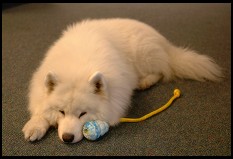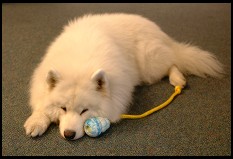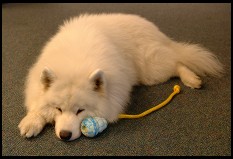
Fuji S1
by Philip Greenspun; created 1997
Site Home : Photography : Fuji S1
Fuji's S1 offers many of the things that one takes for granted with a film camera. It is a single-lens reflex. What you see in the viewfinder is an accurate representation of what will be recorded on film. If you take a picture of your friend and, a split second later, his expression changes to be just right, you can release the shutter again and capture another image immediately. The user interface is sufficiently simple that you could use the camera without reading the manual. Why are these things remarkable? The Fuji S1 is a digital camera. If you've been using a point-and-shoot style digital camera, e.g., Nikon 9xx series, you'll find the Fuji S1 to be an enormously more capable picture-taking machine.
The Fuji S1 is a sub-$3000 3-megapixel camera built on a Nikon N60 body, i.e., the cheapest and most plasticy Nikon film body circa 1998. As such, the S1 accepts more or less the full range of Nikon F-mount lenses. This makes the camera highly suitable for specialized tasks such as macro or wildlife photography.
Eyeglass wearers will find the eye relief of the viewfinder adequate to see the entire frame plus the LCD display underneath. The in-finder LCD shows aperture and shutter speed plus a bar-graph scale for exposure compensation or metering suggestions in metered-manual mode.
The camera operates fast and modelessly. There is no "playback mode" in which you cannot hold the camera up to your eye and take a picture. The camera is always ready to expose a photo.
Instead of a deep menu system, Fuji puts the functions that you really need on a set of four push-buttons on the back. These are right underneath what I'll call the "rear LCD control display", just above the LCD monitor. Normally the display shows date and time, camera ISO setting (320, 400, 800, 1600)--thank you, Fuji, for keeping this in front of the photographer at all times--AA battery level, type of storage media in use, and number of exposures remaining. Press the adjacent "Func" button however and you can use the four buttons underneath to set white balance, ISO, compression level, and image size. Press Func again and the four buttons switch to control color saturation, contrast, sharpening, and multiple exposure mode. You will only very rarely be using the main-screen menu with the Fuji S1. This is a very welcome change from competitive digital SLRs.
The camera retains the Nikon N60s simple on/off switch around the shutter release and mode dial on the top left of the camera. The mode dial offers the usual M, A, S, and P settings plus things like "sports" and "portrait" modes. Once you're in a mode, this is a "one dial camera". For example, if you're in metered-manual mode, the main control dial adjusts shutter speed. To adjust aperture, you press a (clearly labelled with an aperture icon) shift button and simultaneously turn the dial. If you're in aperture-priority mode, the main control dial adjusts aperture. To adjust exposure compensation, you press a shift button and simultaneously turn the dial. I hate this. I like the Canon film and digital bodies: one dial next to the shutter release for your finger; one dial on the camera back for your thumb. It is much faster to work with two dials than one.
After you've taken a picture, press the "Play" button to reivew your work on the LCD monitor. The four magic buttons change to offer Histogram, Erase, Lock, and Mark for Printing. The histogram feature is the best that we've seen on any digital camera. The histogram is an unobtrusive and transparent overlay on top of the still-visible photograph. If you keep pressing the button you can get histograms for individual colors.
Summary: Fuji makes the owners manual available online, but you won't be needing it.
| ISO 320 | ISO 800 | ISO 1600 |
|---|---|---|

|

|

|
Fuji proffers some mumbo-jumbo about pulling 6 megapixels out of their 3.2 megapixel sensor. But unless you want to waste a lot of space on your Microdrive, set the camera to capture at 2304x1536 pixels. According to people who've carefully compared, e.g., Phil Askey's review referenced below, there is no image quality advantage to be had in capturing at 6 megapixels and reducing later.
Working photographers rave about this machine's color fidelity. It seems to be an ideal machine for studio catalog photography. One serious limitation for photojournalism and landscape, however, is that the camera captures only 8 bits per color. You can create 24-bit JPEGs or 24-bit TIFFs in the camera. But there is no RAW mode where a full 10 or 12 bits per color are saved onto the flashcard for subsequent processing. In the studio where lighting is carefully controlled, this isn't a problem. But in the natural world it means that you risk losing highlight and shadow detail at the moment of image capture, never to be recovered again. Below, for example, are a couple of images taken on a sunny day. The S1 has done remarkably well by digital camera standards, even at the standard contrast setting.
| Standard Contrast | Low Contrast |
|---|---|

|

|
(Also check out the image at the very top of this review; the white brick wall behind the shaded subject would typically be completely washed out. But the Fuji was smart enough to preserve some detail in the wall.)
Bottom line: for most purposes, this camera offers image quality similar to that of a Canon D30 or Nikon D1.
You can use the modern Nikon AF-S lenses with this camera but they won't autofocus. The standard Nikon AF-D lenses, where autofocus is achieved via a screwdriver blade turning in the lensmount, work perfectly. Keep in mind that the Fuji S1's imaging sensor is smaller than the 24x36mm frame of 35mm film. So the effective focal length of a lens is multiplied by 1.5. A dramatic 20mm wide angle turns into a boring 30mm semi-wide. A 300mm zoo photography lens turns into a 450mm wildlife photography lens.
When changing lenses, remember that there is a risk of dust falling onto the sensor. Once on the sensor, it will not come off by itself. Pressing a combination of buttons on the S1 results in the mirror locking up so that you can blow dust off the sensor. Keep in mind that some tenacious dirt will require a trip to the professional camera repair shop for cleaning. Don't change lenses in dusty environments (read the Nikon D1 review for a dust-on-sensor story).
Fuji includes some very interesting software with the camera. First and foremost, you can drive the camera from a PC or Macintosh. This is good fun. Click "shoot" with the mouse and you hear a satisfying clunk from the camera. A few seconds later, the image shows up on your computer screen for review. The computer can also drive the camera for time-lapse photography.
Fuji also bundles something called "Exif Viewer". This is for transferring and arranging exposures. I prefer the Zoom Browser EX software bundled with Canon digital cameras. The lack of a mercury switch in nearly all digital cameras (see below) means that roughly half of one's images need to be manually rotated. In the Canon software this can be done by clicking the right mouse button on a thumbnail. With the Fuji software you double-click to open the image. Then you move the mouse precisely over the "rotate left" icon. Then you Save As. Very painful after a few hundred images.
The top-deck contains a weak built-in flash as well as a hot shoe that can drive any Nikon-dedicated flash or a trigger for studio strobes.
The Fuji S1 requires three battery sources: four AAs to run the digital back, two lithiums to run the camera, and a tiny battery to run the clock. The camera is typically packaged with an AC adaptor for studio use.
You can use a CompactFlash card, a SmartMedia card, or an IBM Microdrive in the S1. Oftentimes the camera is sold bundled with a 1 GB Microdrive. One really horrific user interface item: the camera functions perfectly without any storage media loaded. You look through the viewfinder and release the shutter. There is no warning in the viewfinder LCD. You look at the top-deck LCD. There is no warning that the camera is not going to record anything. You look at the rear LCD monitor. There is no warning that the camera is not going to record anything, despite the fact that this LCD is capable of displaying arbitrary text menus. The only indication is a tiny exclamation point in the upper right hand corner of the rear LCD control display and the fact that the number of remaining exposures is "0".
[Note that the Canon D30 has a similar problem. I watched a friend of mine spend 20 minutes photographing his child at the beach before noticing that there was no flash card in the camera.]
The Kodak DCS cameras contain a mercury switch so that JPEGs are correctly oriented when the camera is held vertically. The Minolta Maxxum 7 contains a mercury switch so that it displays correctly oriented text on its rear LCD when the camera is held vertically. The Fuji S1 Pro has no idea whether or not it is being held vertically. Consequently, all of the images that you take vertically will have to be manually rotated in software post-exposure.
If you've got a big Canon lens system, consider the Canon D30. If you need to use Nikon AF-S lenses, go for something in the D1 series (warning: the Nikon user interface is terrible compared to the Fuji). If you don't want to worry about multiple batteries, multiple lenses, a multi-thousand dollar price tag, and cleaning dirt off the sensor, look at the Olympus E10.
 The Fuji S1 is a very nice picture-taking
tool from a group of engineers that obviously understands the needs of real
photographers. It was introduced in the summer of 2000 and therefore we can
probably expect an improved digital SLR from Fuji soon. This should be highly
competitive unit.
The Fuji S1 is a very nice picture-taking
tool from a group of engineers that obviously understands the needs of real
photographers. It was introduced in the summer of 2000 and therefore we can
probably expect an improved digital SLR from Fuji soon. This should be highly
competitive unit.
At right: an example of the high quality metering system in the Fuji S1. The default automatic exposure settings dealt just fine with this backlit subject.
Text and photos
copyright 2001 Philip
Greenspun.
All of the images on this page were taken with the 17-35 Nikon AF-S lens
(manually focussed due to the S1's limitations with AF-S lenses). To download the
full-size image from the camera to your browser, click on a thumbnail, remove the
".half" from the URL, then grab the full-size image. All images were captured at
2304 pixels wide (3 megapixels).